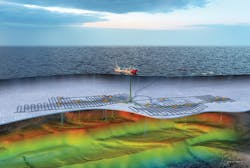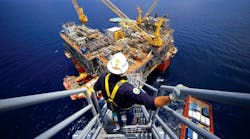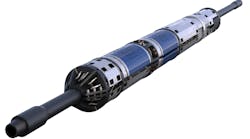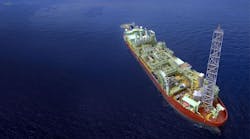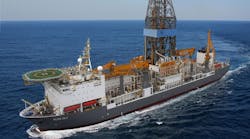Jeremy Beckman • London
Costs still coming down at Johan Sverdrup
Equinor and its partners have submitted their development plan for the second phase of the Johan Sverdrup project in the Norwegian North Sea. This will involve adding a second processing platform at the field complex, five further subsea templates and 28 wells, eventually lifting production to around 600,000 b/d, with a targeted breakeven cost for the entire project of less than $20/bbl.
MargarethØvrum, Equinor’s EVP for Technology, Projects & Drilling, said during a presentation at ONS Stavanger in late August that Phase 1 remained on track for start-up in November 2019, more than a year ahead of the original plan, and at that point, the offshore facilities would be 90% complete, the remainder being outstanding development wells. Two of the four first-phase platforms and the other two jackets are in place, and Saipem’s Castorone has completed installation of the 283-km (176-mi), 36-in. oil export pipeline – the largest on the Norwegian shelf to date – from the field center to the Mongstad oil terminal. For Equinor, it was the company’s busiest offshore installation campaign to date, she added.
Alcatel Submarine Networks will deploy more than 3,700 seismic sensors across an area of over 60 sq km (23 sq mi) for Equinor’s Johan Castberg project in the Barents Sea, to help optimize production from the field. (Courtesy Equinor/Alcatel Submarine Networks)
Phase 2, due onstream in late 2022, will take in the undeveloped satellite Geitungen, Kvitsøy, and Avaldsnes areas and will include a power from shore system that will extend to all developed fields on the Utsira High. Since this February, Phase 2 costs had come down by NKr4 billion ($490 million) to NKr41 billion ($5 billion),Øvrum said, with the overall field development cost presently at NKr127 billion ($25.6 billion), over NKr80 billion ($9.8 billion) lower than the original estimate. At the same time the recoverable reserves range for the full field development has increased to 2.2-3.2 Bbbl, with 2.7 Bbbl the likeliest final figure. The additional 100 MMbbl in the latest estimate is worth over NKr60 billion ($7.36 billion) at current prices, she pointed out, and the ambition is to increase recovery to above 70%.
Among the IOR technologies to be implemented under Phase 2 are the use of fiber optics in the wells; water alternating gas injection; automated drilling control on the drilling platform; high-speed telemetry drill pipe; virtual rate monitoring of subsea wells; and permanent reservoir monitoring (PRM) for the entire field, to be provided by Alcatel Submarine Networks. With PRM, seismic sensors are installed permanently on the seafloor to provide better quality and more frequent images of changes in the reservoir, which should assist modeling and predictive analysis. Equinor has since appointed the same contractor for a similar life-of-field program for its Johan Castberg project in the Barents Sea, involving deployment of over 3,700 seismic sensors across a 60-sq km (23-sq mi) area, with Nexans supplying over 200 km (124 mi) of subsea cable.
Faroes, UK form collaboration
Offshore oil and gas authorities from the Faroe Islands and the UK announced an agreement at ONS to jointly market opportunities for exploration in areas overlapping the two country’s maritime border on the Atlantic Margin. This is in connection with the UK’s 31st offshore licensing round, which opened last July, and an open door, out-of-round license option that the Faroese government is currently promoting following a lukewarm response to the 4th Faroese licensing round earlier this year.
On the Faroese side, there will be a strong focus on the area across the median line in the northern Rockall Trough and Fugloy Ridge, adjacent to newly offered UK blocks. Close by are Chevron’s Rosebank field, which looks to be finally moving toward development and which would be the UK’s deepest water project to date, and the Cambo oil discovery. Here operator Siccar Point Energy and partner Shell recently completed test operations on the final appraisal well, with the oil column delivering higher than anticipated pay, and better than expected petrophysical properties. The well will be suspended for a future development.
The Faroese maintain that their waters too are strongly prospective for oil, despite the largely disappointing drilling results to date, with the Faroese Geological Survey having identified huge subsurface structures in its latest studies.
UK offshore drilling still to recover
UK offshore exploration continues to slide, despite the respectable returns from wells completed over the past two years. According to Oil & Gas UK’s 2018 Economic Report, only four exploration and five appraisal wells were spud in UK waters over the first eight months of this year, compared with 23 in those categories throughout 2017. The main successes in 2018 have been at Cambo and Apache’s Garten discovery, close to its Beryl complex in the UK central North Sea. Potentially higher-impact wells were drilling last month on the Ekland and Plantain prospects, operated respectively by Cairn Energy and Azinor Catalyst, with Equinor set to drill the Pip and Bigfoot prospects. And the association’s review found that wells drilled across the sector during 2016-17 delivered total volumes of over 700 MMboe, almost the same as the previous seven years’ efforts combined.
Development drilling too is down, with only 41 wells in this category over the first half of 2018, against 47 in the corresponding period in 2017. This was a result of reduced infill drilling on existing fields and fewer wells in greenfield projects, in part because the newer UK field developments are smaller in size. If the decline continues, it will ultimately hit production, the report concluded, with older UK wells now being decommissioned faster than newer ones are drilled.
Spirit to fund Greater Warwick Area wells
Hurricane Energy has finally found a partner to help open the potential of its basement oil discoveries west of Shetland. Spirit Energy, formed last year following the merger of Centrica’s upstream and Bayerngas’ Norwegian division, has agreed to farm into 50% of Hurricane’s Lincoln (P1368 S) and Warwick (P2294) licenses, 100 km (62 mi) west of Shetland, comprising the Greater Warwick Area (GWA). Spirit will also fund the cost of a $180-million campaign of three horizontal wells on the GWA from 1Q 2019 onwards, using the semisub Transocean Leader. It will target the 2016 Lincoln discovery and the undrilled Warwick prospect, thought to hold over 1.5 Bboe.
If the program and subsequent tests are successful, the wells would be suspended as future producers with the partners then knuckling down to front-end engineering design for a combined development, with Spirit taking over as license operator. •


